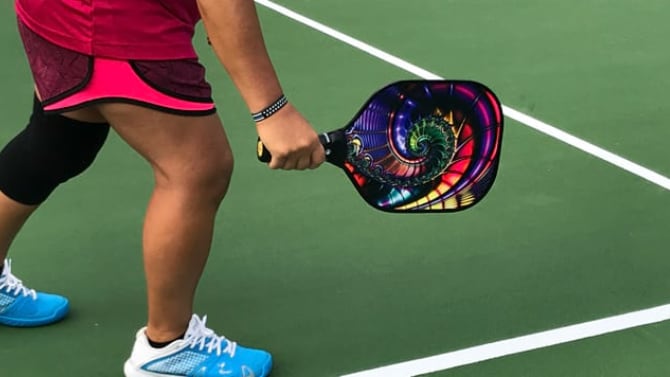The pickleball paddle holds the key to an enjoyable game, making it the single most crucial piece of equipment you’ll need. As the sport gains rapid popularity, a plethora of new paddles flood the market, making the selection process challenging.
Amidst the various eye-catching designs and shapes, it’s vital to prioritize the main specifications when choosing the perfect paddle: material, weight, head size, and grip. By keeping these key factors in mind, you can ensure a paddle that complements your playing style and maximizes your pickleball experience.
The best way to find a right paddle for you is to try them out. Ask anyone at the club about what paddle they prefer and play with and ask to try it out. Trying few different paddles in subsequently will give you better understanding of your preferences.
If you are a beginner or just want to try pickleball – a “social” visit to the nearest pickleball courts is where you want to start. Ask other players if they have any older used paddles you can buy or borrow. Most experienced players have gone through several and will gladly help you out. If you get “hooked” (most people do) than it’s worth to spend a little bit of money as a good quality paddle should last for about 2-4 years for a casual player.
Pickleball paddle material options
Pickleball paddles typically are made out of wood or composite. Composite paddles can have a different combinations of materials for the core and face of the paddle. Each has its own characteristics and feel.
Wooden pickleball paddles
Pickleball racquets made out of wood is where it all started, while new technology provides with more attractive options, the durability of wooden paddles still makes popular, especially among schools and other institutions.
Wooden pickleball paddles are generally heavier than paddles made out of other materials, they are also the least expensive ($10-$30). Because of their price range, wooden paddles are a usual choice for the first paddle. Wooden paddles are extremely durable and will last longer than any other material.
Since wooden paddles are heavy they provide with more power for your shots, but you lose some maneuverability and control. Heavier weight can also cause some arm fatigue and elbow problems. Wooden paddles are considered quiet, but they don’t provide with that satisfying “pop” also.
Also wooden paddles are “afraid” of getting wet as it can warp or peel, and being dropped.

Composite pickleball paddles
Composite paddles are constructed from a combination of different materials, where the core of the paddle is built out of composite panel with honeycomb structure and the face of the paddles typically made out of graphite or fiberglass.
Paddles with the graphite face are light and stiff and provide players with better “feel” – they are also the most expensive. Where fiberglass face gives the paddle more “pop” and comes textured top layer which some players prefer.
Fiberglass composite paddles are the most popular choice as they are priced in medium range ($50-$150) and come in variety of weight and design options. Many pickleball players prefer composite paddles over the wooden ones and if you are looking to buy a first paddle we recommend you “invest” into a cheaper composite paddle rather than wooden one.
Wooden pickleball paddles vs composite paddles
When it comes to pickleball paddles, two popular choices are wooden and composite paddles. Wooden paddles offer a classic feel with a natural touch, providing players with a traditional playing experience. On the other hand, composite paddles are crafted using a combination of materials for the core and face, offering a wider range of options in terms of weight, power, and control.

Wooden paddles are known for their durability and affordability, making them a great choice for beginners or casual players. However, composite paddles are favored by many experienced players due to their advanced technology and customization options.
While wooden paddles are generally heavier, composite paddles come in a variety of weights to suit different player preferences. Additionally, composite paddles often have a larger sweet spot, enhancing shot accuracy and power.
Ultimately, the choice between wooden and composite paddles boils down to personal preference and playing style. Both types have their advantages, and the best paddle for you will depend on your skill level, budget, and individual needs on the pickleball court.
Pickleball paddle weight
Pickleball paddles weight varies from 6 to 14 ounces, it’s a big difference and it highly affects your game and comfort. This why weight is the most important factor when choosing a pickleball paddles. Heavier paddles more drive but provide with less control and vice versa.
Paddle weight is entirely a personal choice depending on your style and physique. For beginners it’s recommended to start with middleweight paddle weighting around 8 Oz.
Also you must consider that heavier paddle will add to the fatigue and can cause “tennis elbow”, shoulder or hand injuries. A very light paddle (under 7 ounces) will require much more effort swinging to generate the power that will also cause the fatigue and harder on the joints.

Pickleball paddle grip size
Grip size plays an important role to the comfort of the paddle. The key is to find a grip size that feels comfortable, prevents stress on your body and allows for the full range of motion.
Pickleball paddles comes in 4 different sizes: 4, 4 1/8, 4 1/4 and 4 1/2 inch in circumference.
There are 3 methods to go about choosing the right grip, and this applies to both women and men:
- By height:
- Under 5’2″…….4 – 4 1/8 inch grip
- 5’3″ to 5’8″…..4 1/4 inch grip
- 5’9″ & taller…4 1/2 inch grip
- Index finger test
While holding the paddle with your dominant hand, use the index finger of your other hand to slide it in-between your ring finger and palm. The best pickleball paddle grip size for you will be the one where your index finger fits snugly within this gap. Not enough room indicates that grip is too small, and too much room – grip is too large. - Ruler Test
Take a ruler and measure your playing hand from bottom lateral crease of your palm to your ring finger to to the tip of your ring finger.
If you are stuck between two sizes, choose the smaller one as you can use overgrips to increase the size of the handle.An overgrip adds between half or one whole size (1/16 to 1/8 inch) to the paddles handle.



